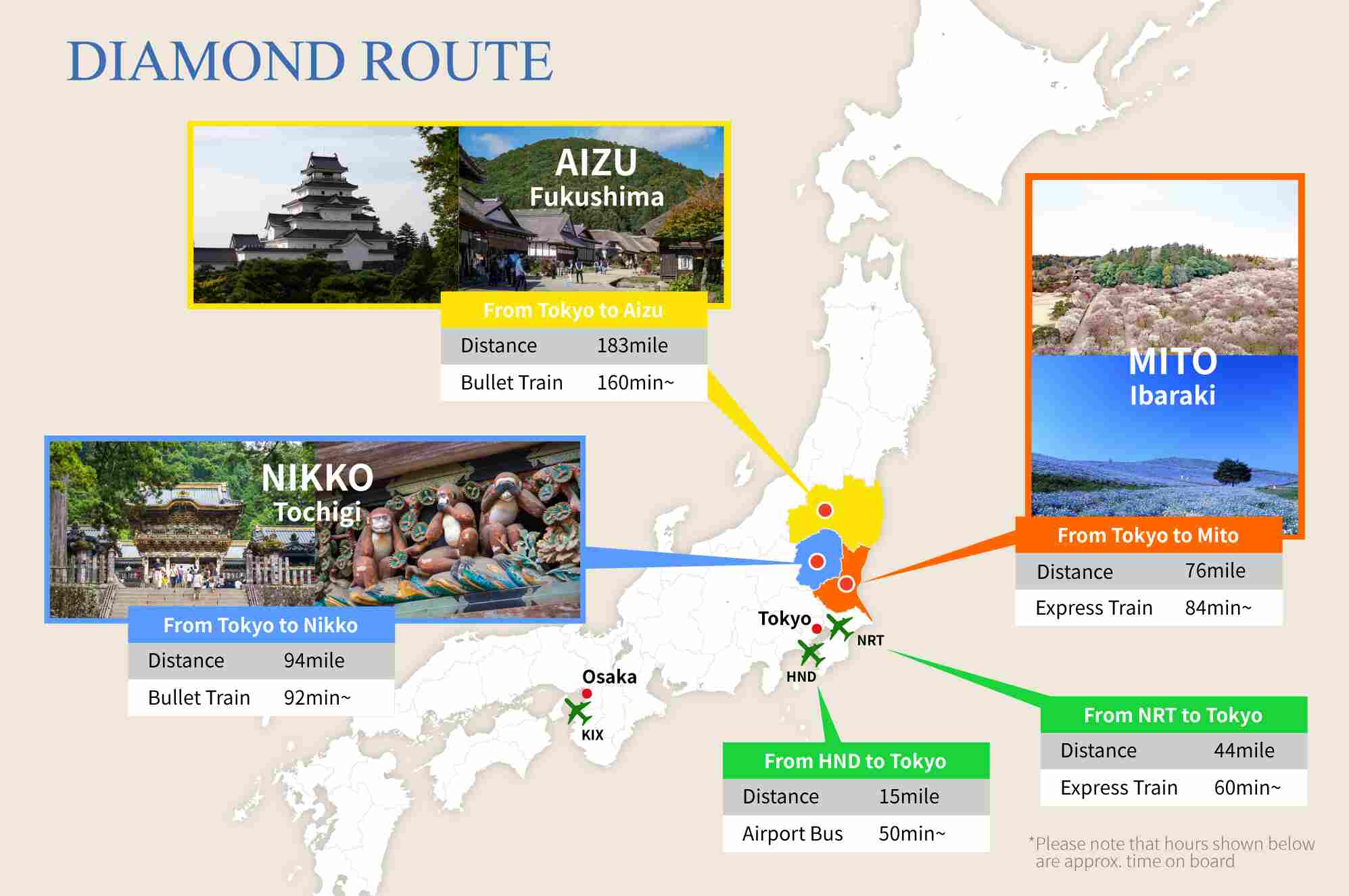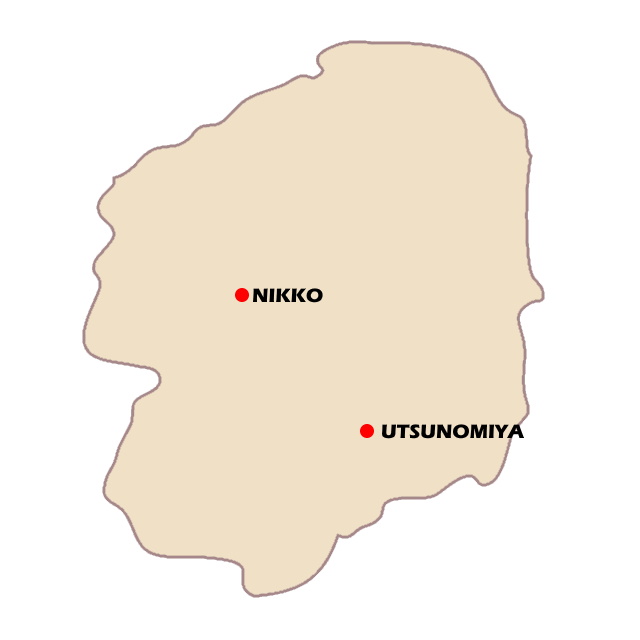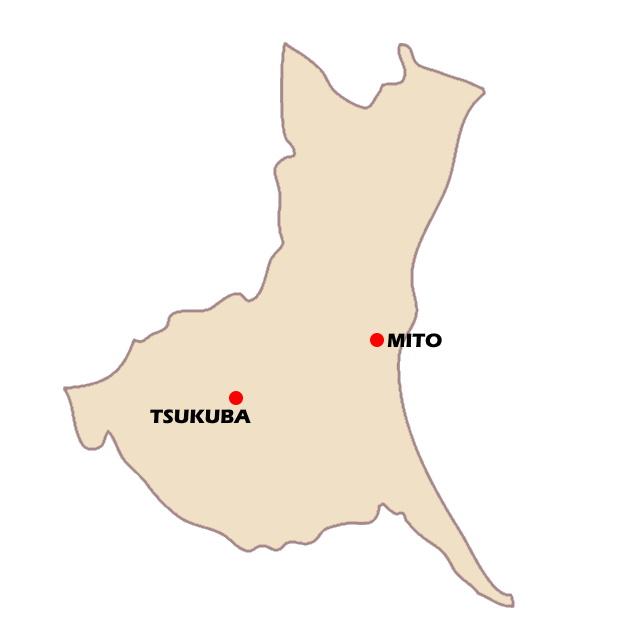1
Tsurugajo Castle
~Aizu Wakamatsu~
Tsurugajo Castle, known as Aizu-Wakamatsu Castle, is arguably Tohoku’s most impressive castle. The history goes back to the 14th century,
although it was mostly demolished in 1874 and reconstructed in 1965. It is remembered for its role in Japan’s civil war, when it was one of
the last remaining samurai strongholds. The castle site is popular as one of cherry blossom viewing spots or the autumn foliage and allows visitors
to enjoy Aizu-Wakamatsu’s history, nature and tradition.
2
Kairakuen Garden
~Mito~
Kairakuen is one of the three famous gardens in Japan along with Kenrokuen in Kanazawa and Korakuen in Okayama.
In July 1842, the 9th feudal lord of the Mito clan, Tokugawa Nariaki, opened the park as a resting place for the people of the territory.
While most Japanese gardens are famous for their cherry blossoms, Kairakuen is famous for its plum blossoms.
Every year, about 3,000 plum blossoms bloom ahead of spring and transform the garden into a beautiful landscape.
3
Soma Nomaoi Festival
~Minamisoma~
Soma Nomaoi Festival is a traditional annual summer festival (usually the end of July), where armored equestrian warriors race to capture sacred flags.
An Important Intangible Folk Cultural Property of Japan, the festival has history over1,000 years. It has its roots in the training of horses in the field
as part of military exercises, and in the ceremony of capturing wild horses. The horses caught as part of this ceremony would be kept at the local shrine
and given an almost deity-like status. The festival has gradually changed over time. Nowadays, visitors can enjoy an action-packed few days, which maintain
the atmosphere of the warring states period.
4
Kanmangafuchi Abyss
~Nikko~
The little gorge formed by an eruption of nearby Mt. Nantai is a sacred and mysterious spot. There are approximately 70 stone statues of Jizos
(Buddhist Guardian Deity) standing in a line along the stream of the river. Take a nice walk on the historical path and enjoy the scenic beauty
in the seasons of spring verdant greens, autumn foliage and snowy Jizos.
5
Kasumigajo Park
~Nihonmatsu~
Kasumigajo Park actually contains the remains of two castles, with the later Nihonmatsu Castle built in the 17th century.
The castle fell in a brutal battle during the Boshin Civil War to government forces. In 1872, the castle ruins were demolished,
although the walls remained. A gate and turret were rebuilt in 1982, with further restorations completed in 1993.
The site became a National Historic Site in 2007.
6
Kendo Lesson
~Nihonmatsu~
Visit Nihonmatsu city in Fukushima to participate in traditional Kendo experience in learning the history and
the manner of Bushido. Kendo is a Japanese martial art that is derived from Kenjutsu (Japanese swordsmanship)
and literally means the "way of the sword“. Nihonmatsu is famous as one of ancient samurai cities having strong
roots for Kendo. In the lessons, you may use bamboo swords named “Shinai” and protective armor.
Nowadays, Kendo is widely being practiced not only in Japan but in the world.
7
Nisshin-kan, A Samurai School
~Aizu Wakamatsu~
The Nisshin-kan was the highest educational institution that the Aizu Clan had. Its purpose was to
produce elite members in a society. The sons of samurai families entered the Nisshin-kan when they
turned 10 years-old. The facilities included a gym for martial arts, an observatory, the oldest
school pool in Japan, and more. Visitors can see the fine architecture of the Edo period, as well
as the schooling methods of the Nisshin-kan. There are also several hands-on activities such as
Japanese archery, zen practice, painting local crafts, and so on.
8
Lake Hibara
~Urabandai~
The highlands of Urabandai boast some of the best scenery and skiing fields in Fukushima Prefecture. Bring your camera to capture dramatic shots of lakes framed by majestic mountains. Volcanic eruptions formed the dramatic landscape, creating a collection of multicolored lakes and ponds. The Goshikinuma (Five-Colored Lakes) walking trail leads past these stunning bodies of water, flashing brilliant hues of red, green and aquamarine.
9
Hot Springs
~Ashinomaki Onsen~
Ashinomaki Onsen is conveniently located just 30 minutes from the heart of Aizu Wakamatsu City, perfect for an overnight stay or day trip and close to tourism spots such as Ouchijuku, Tsurugajo Castle and the Aizu Bukeyashiki, etc.. Ashinomaki boasts beautiful valleys and natural hot springs with abundant hot water where you can relax and enjoy the feeling of falling back in time, surrounded by the beauty of Aizu in all four season. Tourists visiting nearby Lake Inawashiro and Urabandai are always welcome, too.
10
An Old Post Town
~Ouchi-juku~
Tucked among the Aizu mountains, a quaint little town full of thatched-roof houses appears as if out of a dream. The pastoral beauty of Ouchi-juku is like something out of the world of a storybook. Formerly served as a post town in the main route of rice to Edo (the name of old Tokyo) during the Edo era, it is now preserved in fashion of its original appearance, lined with buildings that are characterized by thatched roofs.. Though no longer used as a main point of trade routes, Ouchi-juku still remains preserved as a designated Group of Traditional Buildings by the Japanese National Government.
11
Toshogu Shrine
~Nikko~
Nikko Toshogu enshrines the most famous samurai leader Tokugawa Ieyasu. Its carved and brilliantly decorated structures is part of the Shrines and Temples of Nikko UNESCO World Heritage Site and the highlight of any visit to Tochigi. The ingenuity and careful attention to detail that went into constructing Nikko Toshogu Shrine is extraordinary. Its vibrant colors and flamboyant carvings stand in stark contrast to much of Japan’s more spartan design.
12
Kegon Waterfall
~Nikko Nat’l Park~
Kegon Waterfall is the most famous of Nikko’s 48 waterfalls. Water from Lake Chuzenji falls 97 metres straight down to the rocks below creating a dynamic and artistic work of nature. A special lift takes visitors to the basin where the force and roar of the water can be witnessed close up. Impressive in any season, the waterfall looks particularly spectacular when surrounded by the color in autumn, small streams of the frozen waterfall clad in blue ice during winter season.
13
Local Japanese Cuisine
~Utsunomiya~
In Japan, different regions have their own traditions of agriculture, produce and recipes and many of the specialties are
only available regionally. While traveling around the Diamond Route, discover new favorites and enjoy a taste of the local culture.
Sauce Katsu Don
Aizu-Wakamatsu, Fukushima
Sauce Katsu is a staple of Fukushima cuisine and no one does it better than the restaurants in Aizu-Wakamatsu.
Enter just about any restaurant in the city and you’ll be served a panko-crusted pork cutlet drenched in a sweet,
spicy and sour sauce that will make you jump for joy. What makes Aizu-Wakamatsu Sauce Katsu stand out from the rest,
is the ability to source the highest quality ingredients from their local area. For example, Egoma Pork is specifically
grown and developed by the Fukushima Livestock Research Institute. The pigs are fed perilla seeds to increase the amount
of essential fatty acids and flavor throughout the meat. The other ingredients (i.e. rice, cabbage, etc.) are also sourced
locally to create a dish you can only experience in this city. The amount of attention they give to this dish shows the
dedication and heart of the Aizu-Wakamatsu people.
Kitakata Ramen
Kitakata, Fukushima
When you think of ramen in Japan, there are three distinct varieties that span the whole country.
The three are, Sapporo Ramen, Hakata Ramen and Kitakata Ramen. Each of these ramen bowls has a distinct flavor profile
(salt, pork, soy sauce), unique toppings (i.e corn, pork, butter, chashu, etc.) and a specific type of noodle
(thin, thick, smooth, textured, etc.). You’re in luck because one of the major ramen varieties is only a few hours from
Tokyo. Kitakata ramen in Fukushima prefecture is mainly a soy-sauce based ramen that is light, flavorful and filled with
umami. This simple broth made with the mountain spring water nearby and hand-crumpled curly noodles is the main attraction
throughout this city. With over 130 ramen restaurants in Kitakata, you’ll be able to eat all sorts of Kitakata ramen in a
few square miles!
Tochigi Wagyu
Utsunomiya, Tochigi
You can eat a savory meat raised in Tochigi, “Tochigi Wagyu” which has often won top prize at competitions across Japan for
it superior quality. It is the Number One brand of beef in Japan. .There are approximately 200 restaurants in Tochigi
Prefecture where you can eat Tochigi Wagyu at more moderate prices than Tokyo. You can enjoy it prepared in different ways
such as steak, grilled and in sukiyaki.
Gyoza
Utsunomiya, Tochigi
Gyoza! One of Japan’s greatest dishes. Meaty, flavorful, crunchy, hot, and juicy. If those words don’t make you drool,
I don’t know what will. If you happen to be in Utsunomiya, Tochigi, lucky for you, you’re right in the middle of gyoza heaven.
With more than 200 hundred gyoza restaurants, you can feast on all types of gyoza from pan-fried, steamed, and deep-fried with
various meats stuffed inside! Reasonably priced and delicious, there is no better way to eat your way through Utsunomiya.
Enjoy while it lasts because you won’t be able to eat this quality of gyoza outside of Utsunomiya, Tochigi.
Nikko, Tochigi
Pudding Dessert
If you never tasted Japanese pudding in your life, you’re surely missing out. Japanese people pride themselves over the silky
smooth, creamy, almost melt in your mouth pudding. If you want to experience this type of Japanese pudding at a reasonable price,
look no further than Pudding Tei in Nikko, Tochigi. The care they take in order to create this decadent dessert is what makes this
stand out from the rest. At Pudding Tei, the raw materials and manufacturing methods are changed for each flavor and they
specifically use only the egg yolk from the finest eggs in Japan. After you walked around Toshogu Shrine or Shinkyo Bridge,
walk a couple minutes down the road and you’ll find your favorite pudding spot in Japan.






